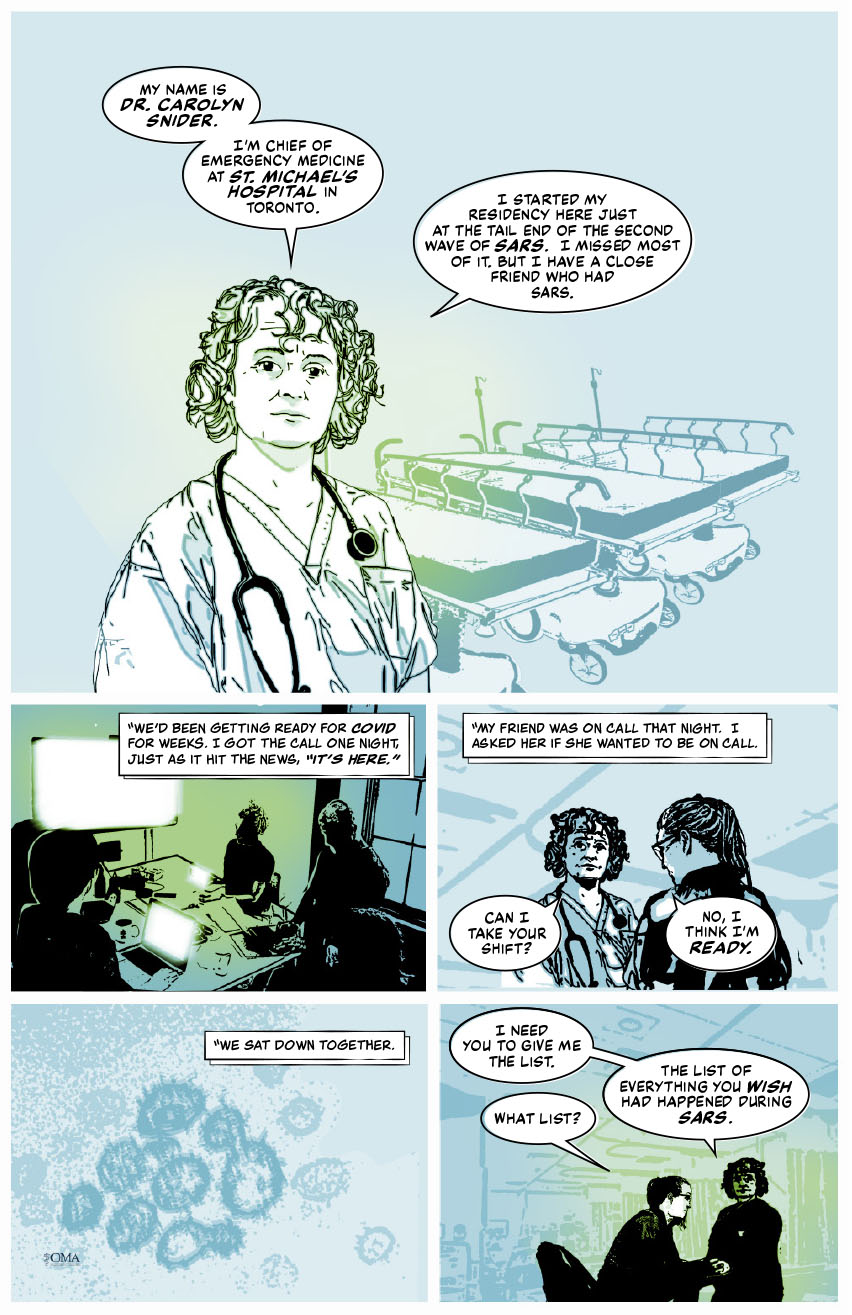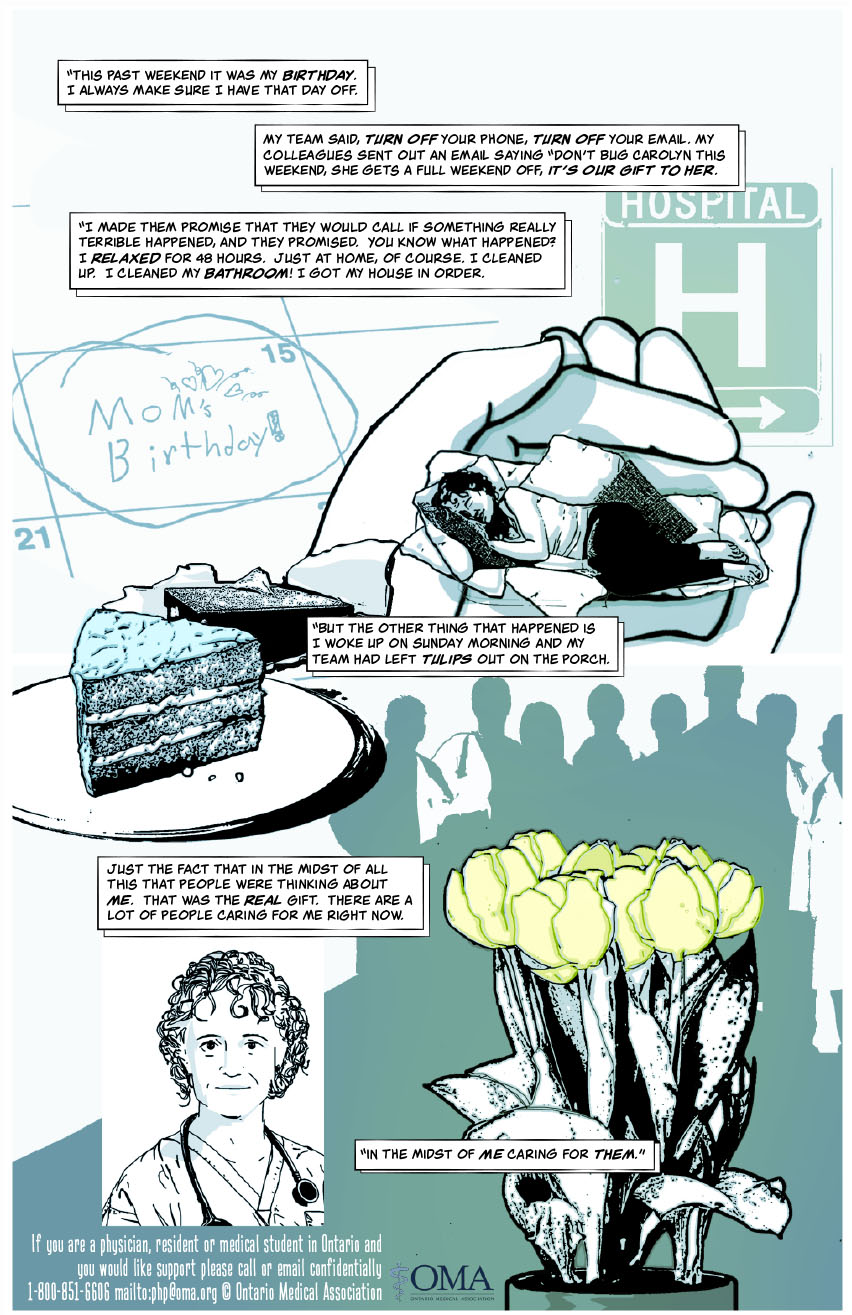This article originally appeared in the May/June 2020 issue of the Ontario Medical Review magazine.
OMA “graphic novellas” highlight impact of COVID-19 on Ontario physicians
The OMA used a “novel” form of communication to highlight the work of physicians during COVID-19 and how it impacted them personally. The Physician Health Program (PHP) commissioned a series of four “graphic novellas” – short stories told through a combination of text and art, often in a comic-strip or comic-book form – to highlight the fears, emotions and frustrations of real Ontario physicians, with the goal of helping other physicians recognize and deal with their own feelings during the pandemic.
The PHP, which supports physicians suffering with mental health issues and other behaviours, reached out to Dr. Jillian Horton, an author and general internist at Health Sciences Centre Winnipeg, to produce the novellas.
Dr. Horton, who did her medical training at McMaster University and residencies in Toronto, has an interest in “graphic medicine,” the role that comics can play in health care. She stresses that despite the art form, it is a serious genre, one that appeals to a younger audience or other busy physicians who might not be inclined to read a dense, two-page handout on wellness.
“This way of storytelling is a form of knowledge translation that allows us to get right to the heart of the matter,” said Dr. Horton. “We can use transparency of thinking to show the steps many of us are going through right now to find a way to cope, including our vulnerabilities and how we find ways to work through them. It’s a quick way to penetrate to the heart of someone’s experience, to save the mind some of the work, to let the words and images do it.”
The first in the series Sketches From the Frontlines featured OMA Past President Dr. Sohail Gandhi reflecting about how COVID-19 forced him to change how he cared for patients in his practice in Stayner.
In one scene, Dr. Gandhi, wearing a face mask and other personal protective equipment, tells an elderly woman in a retirement home that her grandson can’t come to visit. “The look on her face, it would break your heart.”
In another, he is seen rubbing his eyes at the end of a long day, his desk strewn with papers.
“This is different in scale,” he says of this stage in his 29-year career as a family physician, which spanned the early days of AIDS through SARS, H1N1 and now COVID-19. “But we’ve always gotten through it before and we have to remember we’ll get through this, too.”
The second novella focuses on Dr. Carolyn Snider, Chief of Emergency Medicine at St. Michael’s Hospital, a busy Level 1 trauma centre in downtown Toronto.

Dr. Snider said many of her staff remember working through SARS, so in the early days of COVID-19 “there was a lot of trauma” for them. “You can see it’s still there for them. It was very real,” she said. “But like most people, the thing I worry most about is my family…thinking about what it means to finish a shift, to make sure I don’t bring anything home.”
Dr. Snider spoke of the need for frontline health care workers to take a break from the intensity of their work, which is why she took a weekend off for her birthday. Her colleagues sent out an email saying, “Don’t bug Carolyn this weekend. She gets a full weekend off. It’s our gift to her.”
And what did she do with her time off? She cleaned her bathroom and got the rest of her house in order. When she woke up on the Sunday, her colleagues had left a bouquet of tulips on her porch.
“Just the fact that in the midst of all this, that people were thinking about me, that was the real gift,” she said. “There are a lot of people caring for me right now, in the midst of me caring for them.”

The third novella in the series will feature Dr. Ben Fung, a resident in general surgery who has developed a resilience curriculum at the University of Ottawa. Dr. Horton is still mulling topics for the fourth novella.
The PHP had been impressed with Dr. Horton’s work at the last international conference on physician health in 2018 in Toronto, said Dr. Joy Albuquerque, Medical Director of the Physician Health Program.
“Her passion for storytelling and use of a new medium was compelling in her workshop,” Dr. Albuquerque said.
“Dr. Horton literally jumped at the chance when asked by the PHP’s Director of Clinical Services, Ted Bober, if she might be interested in collaborating with us with COVID-19 in mind.”
Dr. Horton had been a resident in Toronto during SARS, so she remembers vividly how challenging it was then for all health care workers.
“The idea of developing these works was to tell part of the story for us as a profession, to be accessible to all and to be a potential tool to help us remember and plan more expediently for the next crisis or pandemic,” said Dr. Albuquerque.
Dr. Horton became interested in graphic medicine when she was associate dean of undergraduate student affairs at the University of Manitoba’s medical college and was looking for ways to engage students with her office. She said she was inspired by Art Spiegelman’s Holocaust-themed graphic novel Maus as an example of how a comic-book style can powerfully convey dark content.
She also wrote a not-quite-autobiographical graphic novel, Medicine, which focuses on the intense challenges faced by a female medical student. Her co-author, GMB Chomichuk, an award-winning Winnipeg graphic artist, is also the artist for Sketches From the Frontlines.
Dr. Horton has a book on burnout and physician wellness being published by HarperCollins Canada in 2021.